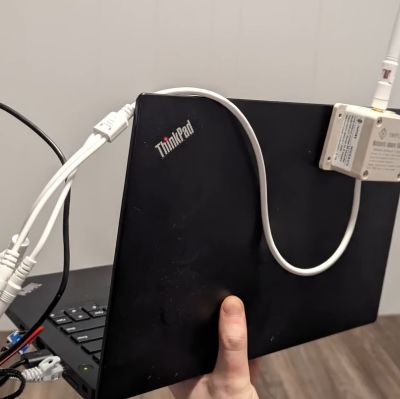
The 802.11ah WiFi (HaLow) standard is fairly new, having only been introduced in 2017. It’s supposed to fall somewhere between standard WiFi used in domiciles and offices and the longer range but low-bitrate LoRaWAN, ZigBee, and others, with bandwidth measured in megabits per second. In a recent video, [Ben Jeffery] looks at the 802.11ah chipsets available today and some products integrating these.
The primary vendors selling these chipsets are TaiXin Semiconductor (TXW8301), Morse Micro (MM6108), and Newracom (NRC7394), with a range of manufacturers selling modules integrating these. Among the products using these, [Ben] found an Ethernet range extender kit (pictured) that takes 12V input as power, along with Ethernet. Running some distance tests in a quarry showed that 300 meters was no problem getting a strong signal, though adding some trees between the two transceivers did attenuate the signal somewhat.
Another interesting product [Ben] tested is what is essentially an 802.11ah-based WiFi extender, using an 802.11ah link between the server node – with an Ethernet socket – and a client that features a standard 2.4 GHz 802.11n that most WiFi-enabled devices can connect to. Using this, he was able to provide a solid ~10 Mbps link to a cabin near the main house (~10 meters) through two outside walls. What makes 802.11ah so interesting is that it is directly compatible with standard Ethernet and WiFi protocols and uses the 900 MHz spectrum, for which a wide range of alternative antennae exist that can conceivably extend the range even more.
(Thanks to [Keith Olson] for the tip)

















I wonder how it compares to some older Ubiquiti 900MHz point to point links that are basically reprogrammed LTE chipsets.
The Ubiquiti M900 was a standard 2.4GHz chipset with a up/down converter attached. If you cranked the power up, you could just barely see it on a standard 2.4 device if you put them next to each other.
Ben from the video here!
I haven’t used the M900 stuff, but I have used a lot of Cambium/Motorola 900MHz fixed wireless stuff at work. The M900 is downconverted 802.11n 2.4GHz, so certain behavior of how it handles noise/weak signals will be similar to 802.11n 2.4GHz. The main advantage that the M900 would have is that it’s dual chain, so in good conditions you’re essentially able to double the performance of the wireless link.
802.11ah stuff is single chain, so the upper capacity isn’t as good (Around 16 Mbps on the cheap TaiXin Semiconductor based stuff), but from testing and going from other anecdotes, it seems to handle noise better and it degrades more gracefully when it gets into the lower signal levels. That’s perfect for IoT and other low bandwidth situations, because getting a reliable 0.5 Mbps could be plenty for a lot of applications compared to being able to get 30 Mbps on the high end and start crapping out once the signal starts getting slightly weak.
The cambium pmp450i’s that could do 900MHz have been discontinued; my work just bought the last 4 subscriber modules they could find. It’s a shame, because even as little bandwidth as there is, they were the only way to reach some places for point to multipoint.
so it uses wpa2 encryption?
you can modify the settings on these chips, you can find details in the links I posted here:
https://github.com/markqvist/Reticulum/discussions/421
Fantastic resource, thank you!
I would love to see more 802.11ah equipment such as access points and USB wifi adapters. Doing a quick search, I mostly just found wireless bridge equipment.
I did a bit more searching and I actually found such products made by Alfa. Problem is, it appears most of it is $100+USD, based on finding a website that actually sells some of the listed products.
https://www.alfa.com.tw/collections/wifi-halow
This one is amazing!
https://www.sparkfun.com/products/19956
Wow… I like sparkfun, but I never thought I’d see the day where any of their products were considered cheaper than the competition! Given the prices of 802.11ah equipment, that’s a downright amazing price.
In my video, I really briefly mentioned that Alfa has a USB C dongle, which I think would be really nifty if it works with Windows/Android/ect.
You could have the AP on a small tower or buillding, then have a tablet or laptop with the dongle strapped to it (or built into some sort of case), and be able to walk around a large park, jobsite, farm, ect in a cellular deadzone while still being connected. Almost like a two-way radio replacement.
I was just researching 802.11ah a couple days ago, considering connectivity options for some remote stations I’m developing. I found that there are really no cost effective radio options, which is a shame because it’s really the only option to build a wireless IP LAN at this range.
LTE Cat-M and NB while not directly comparable technologies are much more mature. I can get a SIM7080 modem that can operate on Cat-M nearly anywhere in US & Canada for <$20. Paying for data sucks, but IoT specific SIMs are getting pretty cheap from vendors like Hologram.
My first wireless connection for my laptop was in the 900mhz band. I think it could only work with a single device IIRC.
Your documentation hit home with the tractor suggestion. No cellular sunshine at the farm, so a robust link to a tractor with 802.11ah to 802.11n conversion would be great. Or a NLOS thru tree’s PtP link to an amateur radio repeater location for telemetry, like you show on your web site with a Renogy charge controller. Remote cameras another great application. 1 Mbps would be sufficient in these cases. LORA or Meshtastic is too slow. Cost and simplicity comparison with off-the-shelf 5GHz link to a 2.4GHz directional gain AP (as with 10dBi gain antenna). The question is if the use case is too rare to see expanded commercial offerings. In urban areas, 900 MHz is pretty busy, with spread spectrum data (municipalities like this on their water towers, traffic lights, water wells), baby room monitors, home automation (Insteon), etc. But in rural areas, it should be clean.
I used to work for a company that made 802.11g radios that would go a couple miles. They just used 1 Watt of transmitted power to do it. They can’t get parts to make them any more. Specs : https://www.esteem.com/wp-content/uploads/195Eg.pdf
They have 1/2 Watt models now.
I’m not sure it’s legal to operate them without a proper license, though…
it’s not legal to replace a 1/4 omni with a directional antenna either (you exceed the EIRP) and people do it…what matters is checking for harmonics, band usage and that kind of stuff, just not being a dick in general…
Laws stops at your border.
In the USA you can run 1 Watt in the ISM band with a 3 dbi antenna.
some of the most important provisions of this standard made it into 802.11ax (specifically TWT). There are articles calling 802.11ax “the new HaLow” standard
Cell phones would also have to be able to connect to 802.11ah.
I picked up a pair of the cheapest bridges I could find advertising 802.11ah, and there are no security settings to be found, no config interface at all, actually.
Has anyone poked at the security of this junk?
There is a company out there that is producing 802.11ah chips with 8mhz. Morse Micro’s MM6108 . The 8mhz channel may offer twice the throughput 30mbps as the others who only go up to 4mhz. 8mhz is available for use in the US. https://www.cnx-software.com/2022/10/27/wifi-halow-iot-gateway-is-based-on-morse-micro-mm6108-802-11ah-chip/
Silex, another company who has partnered with Morse is working on a pi 4 hat with the same chip but has not been released as of yet. https://www.silextechnology.com/unwired/press-release-silex-technology-introduces-802-11ah-sdio-mm6108-module
As far as I’ve read online there are four chips that could do 802.11ah / HaLow on the market right now: Newracom NRC7292 (NRC7294), Morse Micro MM6108, TaiXin Semiconductors TXW8301 (TXW83xx) and theoretically also Texas Instruments CC1352P.
Newracom seems to have the best software support our there, but even that is somewhat lacking. I couldn’t get the module working over an USB-SPI converter. It’s also really not very mainlined.
I haven’t seen Morse Micro chips being sold at all. Acquiring an EU version of the TaiXin chipset has also been too difficult. The TI one, I’ve only seen mentions of it being usable out there in one paper, that’s all.
The ecosystem seriously needs to open up and get some mainline software support or it’s going to fade out before it gains any velocity.
Someone else posted a link to a RPi hat that already works and for sale $49
Weird. Just saw this standard on a video camera from abode at CES
I’ve seen two articles in one day about this standard now
We’ve had a HaLow devkit based on the Newracom NRC7292 module since 2021.
We’re readying release of a series of products based around the new NRC7394 chip and our own 1W module.
https://teledatics.com
https://github.com/teledatics